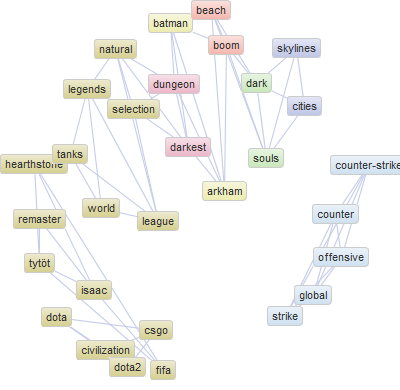06 Jul 2016 ·
1 min read
 Figure: Most Common Keywords in Patents Related to Online Gaming
Figure: Most Common Keywords in Patents Related to Online Gaming
In a recent research project initiated by my colleague the NAILS project was extended to analyse and compare the other major database indexing science and technology results, patents. These results were recently published in a conference and now the preprint is available for your perusal. This is exciting (for a certain definition of exciting), because previously there has not been a freely available bibliometric analysis tool to map and visualize patent data. For now you also need a subscription to Web of Science to download patent metadata for analysis.
Read More
Preprint is available in ResearchGate.
Continue reading
30 Jun 2016 ·
1 min read
 Figure: Unity Development Environment
Figure: Unity Development Environment
There are many approaches to teaching the basics of programming from traditional lecture-type teaching in universities to interactive courses (CodeCademy) to MOOCs (mooc.fi). I recently taught a basics of programming course to teens, arranged by the local center of STEM education, LUMA. The course lasted for five days with the goal of introducing complete novices to the basics of programming (variables, control structures, loops) and the basics of game development.
One of the basic premises for the course were that students are more highly motivated to learn programming when the skills have immediate and interesting opportunities to apply. That is why the development environment for the course was Unity, which is a physics-engine centered game development environment. The basic interface of Unity resembles an user-friendly 3D modeling program, where one can for example deploy basic geometric shapes or imported 3D models. These objects and the environment can then be further controlled with C# or JavaScript programming languages. For example, it is easy for a beginner to create a pinball game by defining the level, adding a sphere and connecting the flippers to the keyboard by programming.
The curriculum of the course included basics of programming in JavaScript and C#, basic principles of game development and games as a creative industry. The course had positive outcomes, with all students with full attendance passing programming assignments and many participants improved on the basic game template with advanced features like timed platforms and ramps. At the same time they gained very practical feel of what basic programming language features can accomplish by immediately being able to control objects in an environment beyond what a basic command line could offer.
Continue reading
02 Jun 2016 ·
1 min read
 Figure: The Weekly Structure of One Flipped Programming Course
Figure: The Weekly Structure of One Flipped Programming Course
Recently we have explored the application of flipped classroom to teaching computer science and especially in the context of programming courses. Flipped classroom is a teaching method where students first study theory by themselves as a pre-assigned homework and then learn in the classroom by working on exercises. This is the opposite of the traditional “listen at class and then work alone at home” approach, hence the term “flipped”. This approach aims to maximize the usefulness of the time the teacher and the students spend together.
We had a series of case studies with positive results. We first published one short poster paper and then a subsequent full paper. There is also the poster where we have a proposed process model for applying the method and a series of recommendations.
Continue reading
25 Apr 2016 ·
2 min read
 Figure: Games that were associated with each other in the survey results
Figure: Games that were associated with each other in the survey results
The previous two articles on Gamifying CSCL and Building Fair CS:GO Teams are an excellent segue to today’s topic. A year back we made an survey on how motivated video game players would be to exercise for in-game rewards. Additionally we performed a systematic mapping study on current scientific literature handling the topic. We found that it has not been a much researched subject and the attitudes of players were open to connecting video games and exercise by gamification.
Continue reading
18 Apr 2016 ·
3 min read
 Figure: Principal Component Analysis of CS:GO Player Skill Variables
Figure: Principal Component Analysis of CS:GO Player Skill Variables
This post deviates a little from the science publication fare and is related to applied machine techiques and how they can be used in the most unusual places. Let me start first by illuminating the motivation. I am a part of the organizing body of Snooze Ry., which arranges LAN party events for youth. As you might expect, there are computer game (eSports) competitions. However, one of the issues is that the skill level of the participants varies a lot and we aim to maximise fun at the competitions. Many of the games that are played there are team-based and we try to have teams evenly matched to have the matches to be as exciting as possible. Recently we have manually assigned the best players into the different teams, but this is not a long term solution and involves a lot of manual work.
Continue reading
 Figure: Most Common Keywords in Patents Related to Online Gaming
Figure: Most Common Keywords in Patents Related to Online Gaming Figure: Unity Development Environment
Figure: Unity Development Environment Figure: The Weekly Structure of One Flipped Programming Course
Figure: The Weekly Structure of One Flipped Programming Course Figure: Games that were associated with each other in the survey results
Figure: Games that were associated with each other in the survey results Figure:
Figure: